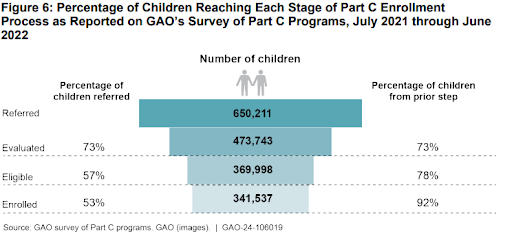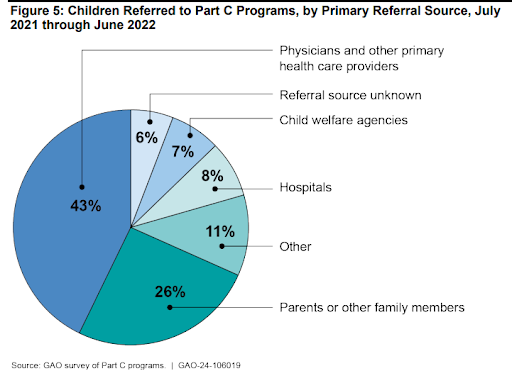New GAO Report Highlights IDEA Early Intervention Programs

The report identified various challenges, including varying eligibility criteria, staffing shortages, and limited data collection, and concluded with several recommendations for Congress.
The first few years of life are critical to children’s development, as they set the foundation for their future growth and learning. Infants and toddlers who have developmental delays or disabilities, or those who are at high risk of developmental delay, are served under Part C of the Individuals with Disabilities Education Act (IDEA). In 2021, more than 770,000 infants and toddlers, from birth through age 2, received early intervention services under IDEA Part C. Early intervention services can set children up with the supports they need to help them thrive.
To analyze barriers states face in carrying out IDEA Part C requirements and inequities in access to early intervention services, the U.S. Government Accountability Office (GAO) released a new report, “Special Education: Additional Data Could Help Early Intervention Programs Reach More Eligible Infants and Toddlers”. In gathering information for this report, GAO conducted a survey of 56 Part C programs (50 states, five territories, and the District of Columbia), analyzed data from the Department of Education, and spoke with Education officials, stakeholders, and other experts.
Overall, GAO found variations in the demographics of children identified and served throughout the enrollment process. The report identified various challenges, including varying eligibility criteria, staffing shortages, and limited data collection, and concluded with several recommendations for Congress.
Key Report Highlights
What is IDEA Part C?
IDEA Part C authorizes federal funding for early intervention services to infants and toddlers with developmental delays or disabilities ages birth to three years. Under Part C, states must provide “a timely, comprehensive, multidisciplinary evaluation” of each child suspected of having a delay. Once a child is determined to be eligible, a team including the parent and qualified personnel identifies the services needed and ensures they are tailored to meet a child and family’s particular needs. Early intervention services may include audiology, vision, speech-language pathology, and psychological services; physical therapy; provision of assistive technology devices; and social work, referral, and coordination services. Each state Part C program follows a similar process to identify, evaluate, and ultimately enroll eligible children in early intervention services.
Who Participates?
Nationally, about 7% of children received services at some point in the most recent 12-month period. The percentage of children who received services varied widely by state, ranging from about 2% in Arkansas to about 20% in Massachusetts.

As evidenced by the graphic above, over one-half of children referred for services ultimately enroll, and rates vary widely by state. For example, in California and Florida, 100% of children who were referred to Part C were evaluated, compared to 37% of referred children in the Northern Mariana Islands.
A variety of factors, including varying state policies, may contribute to these differences. Sometimes children who are referred do not get evaluated for services because parents do not provide consent for their child’s evaluation. This may be because they believe their child’s problem may be resolved over time or they are unaware about early intervention services/processes. Children may not be evaluated because they moved out of a state or because Part C staff were unable to locate the family.
The percentage of children who are determined to be eligible after they are evaluated also varies by state, from less than 50% of evaluated children in some states to 100% in others.

Physicians and other primary health care providers were the most common primary referral source (43%), while parents and families were the second most common (26%). Understanding referral sources helps the state understand the effectiveness of its Child Find system, which is the process that states use to identify, locate, and evaluate infants and toddlers who may need services. It is critical that these referral sources clearly understand the eligibility criteria to ensure children who qualify for services are able to receive them. However, in some states, the percentage of children who are evaluated and ultimately determined to be eligible for services is less than 50%. This may indicate that primary referral sources, including physicians, may not understand the state’s specific eligibility criteria.
What are the Challenges That States Face in Providing Access to IDEA Part C Services?
Early Intervention Eligibility Criteria Vary Across State
Given states can determine which diagnosed disability conditions qualify for Part C services, children may be eligible for services in one state, but not in others.
- States use different definitions of “developmental delay” and different program eligibility criteria for their early intervention programs.
- States consider different conditions as qualifying. 38 out of 56 states have eligibility criteria that include multiple ways a child could qualify for Part C services. 620 unique conditions were included as qualifying for Part C services across 54 states included in a recent study. States listed on average 48 conditions that qualify for services, ranging from none to 167.
- Some states serve “at risk” children who do not currently have an observable developmental delay, while others do not. Eight states have chosen to cover “at-risk” children under their Part C policies.
- Some states extend Part C coverage to children ages 3 through 5 years old, while others do not. Seven states have opted to extend Part C coverage to children 3 through 5 years old.
Staffing Shortages Are Common
Forty-eight states identified a lack of qualified service providers as one of their top challenges in serving eligible families. Provider shortages make it difficult for young children and their families to receive the support they need. 23 states noted staffing challenges within the lead agency as another challenge. Officials noted that they are struggling to attract and retain qualified service coordinators, who play a critical role in helping families understand and navigate the early intervention process, managing the Individualized Family Service Plan, and ensuring the timeliness of services. However, due to multiple roles and responsibilities, it is increasingly challenging as their caseloads increase.
Data Collection Efforts Miss Key Opportunities to Increase Access to Services
Current data and analysis focus exclusively on children already receiving services. The Department of Education does not have the authority to collect or require states to collect demographic data on children in the various stages of the enrollment process. These gaps in data result in potential missed opportunities to increase access to Part C. However, officials noted that “absent a requirement for states to also analyze such data as part of a broader Child Find effort they are uncertain whether requiring states to collect and report such data would help them identify and address whether disparities exist at steps prior to enrollment.”
GAO found that many states are already examining disparities across demographic characteristics. In response to GAO’s survey, 28 states provided race and ethnicity data on infants and toddlers at each stage of the enrollment process from July 2021 to June 2022, which gives some insight into potential disparities in access to Part C services. The data demonstrates that the percentage of infants and toddlers referred who received an evaluation varied significantly by race. There was a 27 percentage-point difference between American Indian and Alaska Native children (59%) and Asian children (86%). However, the percentage of eligible children who subsequently enrolled looked fairly similar, ranging from 91% for American Indian or Alaska Native children to 95% for Asian and White children.
Recommendations
GAO offers several recommendations to help ensure all children who stand to benefit from IDEA Part C services are able to access them. They include:
- Amend IDEA to give the Secretary of Education the authority to require all states to collect and use these data to identify and address potential disparities. This will help to ensure all children have access to needed early intervention services at all points in the process, including the referral, evaluation, and eligibility stages.
- Require the Department of Education to use this data to better support states in their efforts to identify and rectify gaps in access to Part C services.
- Call on the Assistant Secretary for Special Education and Rehabilitative Services to encourage states to use demographic data they already collect to maximize access to services.
- Encourage all states to take the initiative to improve their Child Find efforts and make use of their existing data. Doing so could help state Part C programs identify and serve infants and toddlers who need support as early as possible.
Subscribe to FFYF First Look
Every morning, FFYF reports on the latest child care & early learning news from across the country. Subscribe and take 5 minutes to know what's happening in early childhood education.



